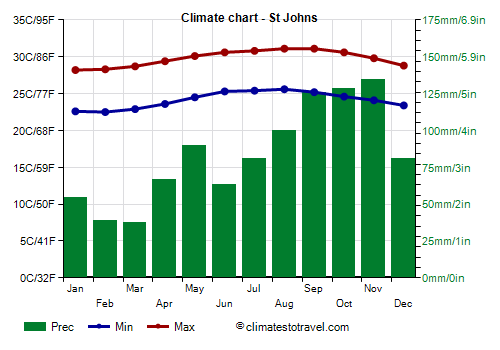Select units of measurement for the temperature and rainfall tables (metric or imperial).
Average weather, temperature, rainfall, sunshine
The climate in Antigua and Barbuda is
tropical, hot and humid all year round, with a relatively cool, dry season from January to mid-April and a hot, humid, and rainy season from mid-June to mid-November.
In the cool and dry season, the
northeast trade winds, constant winds typical of tropical climates, blow steadily and with moderate intensity, while in the hot and rainy season, these winds are more irregular, and may have some breaks, increasing the feeling of sultriness.
Between them, there are two
transitional periods: from mid November to early January (when the northeast wind starts to blow, the temperature decreases a bit and the weather gets better) and from mid-April to Mid-June (when both the temperature and the frequency of downpours gradually increase).
In order to simplify, we can divide the year into
two periods, a dry one from January to June and a rainy one from July to December. The rainiest period runs from September to November, while the driest months are February and March.
Antigua and Barbuda is a small Caribbean state located at 17 degrees north latitude and belonging to the Commonwealth. In addition to the two main islands, Antigua and Barbuda, we find some smaller islands, such as Green Island, Guiana Island, Long Island, and Redonda, plus some islets.
The climate in detail
Temperature and rain
The average daily
temperature is around 25 °C (77 °F) in January and February, while it goes up to around 28 °C (82.5 °F) from June to September.
The
rainfall is not so abundant because the islands are pretty flat; the only elevation of some importance is Mount Obama, 402 meters (1,319 feet) high, in the southwest of Antigua Island.
In Codrington, on the island of Barbuda, rainfall amounts to 1,165 mm (46 in) per year, while in Antigua, it amounts to 1,000 mm (40 in) in the north of the island (see St. John's and the airport), to 1.100 mm (43 in) in the southeastern part, and to 1,300 mm (51 in) in the southwest, near Mount Obama.
St. John's

In
St. John's, the capital, located on the island of Antigua, the average temperature fluctuates between around 25.5 °C (78 °F) in January and February, to around 28 °C (82.5 °F) from June to September.
As mentioned, St. John's is located on the north side of the island and receives about 1,000 mm (40 in) of rain per year.
The rains occur throughout the year especially in the form of
downpours or thunderstorms, which could be intense, but generally do not last long, so they do not reduce too much the sunshine hours; sometimes, however, there may be a more intense wave of bad weather.
In fact, the amount of
sunshine is good all year round.

Sea temperature
The
sea temperature ranges from 26 °C (79 °F) in February and March, to 29 °C (84 °F) in September, so the sea is warm enough for swimming all year round.
Hurricanes
The greatest danger comes from tropical storms and cyclones, called
hurricanes in the Caribbean area, which can pass over the islands from June to November, though they are most likely from August to October. In early September 2017, the archipelago was hit hard by Hurricane Irma.
When to go
The best time to visit Antigua and Barbuda is from
December to April, since it is the least rainy and the least hot period of the year; in particular, the months of February and March stand out as the driest.
In May, both heat and moisture increase, but the rains are still not abundant (except during certain years), and we are still out of the hurricane season.
In the summer months, August and September are a bit rainier in comparison with June and July, and hurricanes are more likely as well.
What to pack
From
December to April: bring light clothing, and possibly a sweatshirt for the evening from December to March. A sun hat, sunscreen.
From
May to November: bring lightweight clothing, and possibly a light sweatshirt and a light raincoat for thunderstorms; a sun hat, and sunscreen.
When going to the reef, you can bring snorkeling equipment, including water shoes or rubber-soled shoes.
Climate data - Antigua And Barbuda
| St Johns |
|---|
|
| Jan | Feb | Mar | Apr | May | Jun | Jul | Aug | Sep | Oct | Nov | Dec |
|---|
| Min temp. | 23 | 22 | 23 | 24 | 24 | 25 | 25 | 26 | 25 | 25 | 24 | 23 |
|---|
| Max temp. | 28 | 28 | 29 | 29 | 30 | 31 | 31 | 31 | 31 | 31 | 30 | 29 |
|---|
| Precip. | 55 | 40 | 40 | 65 | 90 | 65 | 80 | 100 | 125 | 130 | 135 | 80 |
|---|
| Prec. days | 11 | 8 | 7 | 8 | 9 | 9 | 12 | 12 | 13 | 12 | 13 | 12 |
|---|
| Humidity | 75% | 74% | 73% | 74% | 77% | 76% | 76% | 77% | 78% | 78% | 78% | 76% |
|---|
| Day length | 11 | 12 | 12 | 12 | 13 | 13 | 13 | 13 | 12 | 12 | 11 | 11 |
|---|
| Sun hours | 8 | 8 | 8 | 8 | 8 | 8 | 9 | 8 | 8 | 8 | 8 | 8 |
|---|
| Sea temp | 26 | 26 | 26 | 27 | 28 | 28 | 28 | 28 | 29 | 29 | 28 | 27 |
|---|